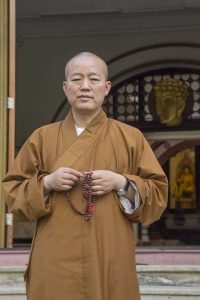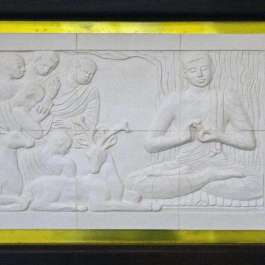Nestled in the protective embrace of the majestic Himalaya, the landscape of Nepal unfolds like a timeless tapestry telling of an ancient culture and a profound heritage, beckoning visitors with an ethereal charm. This is an enchanted land where the whispers of its long history echo down through the eons and reverberate among the imposing and watchful snow-capped Himalayan giants, at the feet of which a kaleidoscope of cultures, faiths, and artistic expressions flourish. At the center of this ever-changing mandala beats the heart of a 2,600-year-old spiritual tradition that has withstood the passing of centuries, flowing through the nation’s sacred valleys like the water of life. Even in the bustling nucleus of Kathmandu, alongside the ever-turning wheels of commerce and materialism, the teaching is sustained; the fragrance of burning incense permeates the air, and every paving stone breathes tales of devout pilgrims and a profound heritage of wisdom.
Yet there lies—a world away from the ceaseless clamor and the dusty thoroughfares of Kathmandu, and the ever-present gentle clack of prayer wheels and mala beads around the stupas and temples that punctuate the urban landscape—one in particular of the aforementioned sacred valleys: Tsum.


Tsum Valley, in western Gorkha District, is one of Nepal’s lesser known jewels. It was officially opened to foreign tourists in 2008 as part of a government effort to promote sustainable tourism, bolster economic development, and highlight the unique cultural and natural treasures of the Manaslu Conservation Area, established in 1998.
The inevitable ingresses of modern tourism mean that Tsum Valley is no longer the hidden secret it was even as recently as 15 years ago, yet the valley is still far enough from the beaten path that its resplendent landscapes and secluded communities retain the mystique of a rich and ancient way of life in Nepal’s geopolitically sensitive border region with Tibet.
Starting at an altitude of some 2,000 meters, Tsum Valley ascends as it meanders toward the Tibetan border to around 3,700 meters, with the surrounding guardian summits attaining even greater elevations. It is home to 33 villages that sustain some 529 households—a population of a little over 1,800 people. The valley is topographically and climatically diverse. The lowest downstream elevations are characterized by lush, warm sub-tropical forests, alive with the buzzing of insects and a bounty of natural food sources such as banana trees, which help to sustain the majority Hindu population that predominates in that locale.

As one pushes onward and upward, each footfall is accompanied by a gradual environmental transformation: the air cools and the tropical vegetation cedes its territorial hold to the proud, aloof spires of coniferous woodlands, among which most of the indigenous people of the valley, the Tibetan-descended Tsumba, have lived, practicing the intertwined traditions of Bon and Vajrayana Buddhism since long before the petty territorial squabbles over modern-day border regions emerged. Here, the depth and breadth of Himalayan Buddhist traditions have flourished in a symphony of spirituality amid the spartan grandeur of the Himalayan wilderness.
Ascending still further up the valley, even the evergreen woods thin out before retreating altogether as we encounter the early reaches of the Himalaya proper. Now there is only low vegetation—patches of scraggly brush, course grasses, and juniper bushes. As a protected environment, hunting and fishing are not permitted in Tsum Valley, which is rich in wildlife, notably the nimble Himalayan tahr and hardy blue sheep that congregate to graze in sizable herds.
The valley is also home to a number of unique and historic Buddhist temples, monasteries, and other landmarks. Among them: Rachen Gompa and Mu Gompa, which stand on a scenic plateau in the lap of the valley, Gompa Lungdang, at the foot of a conical hill, and a revered cave where the Buddhist saint Milarepa himself is believed to have meditated.

Every step across this rugged, undulating landscape, under the eternally patient yet chilling gaze of the the majestic Ganesh Himal, Sringi Himal, and Boudha mountain ranges, is a pilgrimage through time, where the rhythm of footsteps resonates with the hum of sacred chants from monasteries perched on forbidding cliffs.
And it is from the dramatic backdrop of this startlingly beautiful, yet stark and often unforgiving environment that we begin this short series of articles, aiming to highlight some of the unique manifestations of the Buddhist culture and heritage of Tsum, the secret valley.
In particular, we will explore a remarkable heritage conservation project undertaken by American non-profit organization Treasure Caretaker Training, led by conservator and consultant Ann Shaftel and dedicated to the preservation of the world’s remaining authentic Buddhist treasures and relics.

Ann and her team of dedicated conservators have been working closely with community members and with the guidance of local lamas to rescue a veritable treasure trove of sculptures, thankas, murals, paintings, and other artifacts at the aging Lama Guan village temple. Their hope is that these irreplaceable artifacts and symbols of the Buddhadharma may survive and serve to illuminate the lives and minds of many more generations of Buddhist practitioners in Tsum.
It is here, along the twisting, mist-laden ravines and gorges—crisscrossed by suspension bridges hanging precariously above the roiling blue glacial waters that carved the valley—that the soul of Tsum reveals itself: as a sacred sanctuary of Buddhist traditions seamlessly interwoven into the fabric of everyday life; where walking trails are punctuated by numerous chortens and lined with mani walls composed of thousands of carved stone slabs depicting deities and inscribed mantras; where prayer flags flap and flutter ceaselessly, whispering colorful prayers that are carried aloft by the Himalayan winds in an embrace as enduring as the mountains themselves.


See More
Treasure Caretaker Training: The Preservation of Buddhist Treasures Resource
Related features from BDG
Buddhism in the Hidden Valley, Part 2: Heritage Conservation in Tsum
Buddhism in the Hidden Valley, Part 3: An Interview with Khenpo Karma Samdup on the Legacy of Kenchen Thrangu Rinpoche
Buddhism in the Hidden Valley, Part 4: Conservation and Community at Rachen Gompa
Buddhism in the Hidden Valley, Part 5: In Conversation with Rachen Gompa’s Geshe Tenzin Nyima
Related videos from BDG
Buddhist Heritage: Conservation and Creation (BDG YouTube)



















